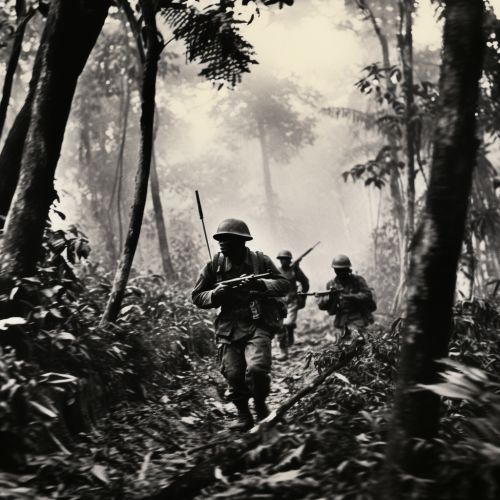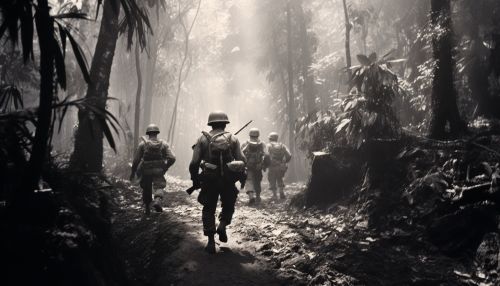Indochina Wars
Origins of Conflict
The Indochina Wars were a series of conflicts in Southeast Asia from 1946 to 1989, primarily fought in Vietnam, Laos, and Cambodia. The wars were rooted in the region's struggle for independence from colonial rule, particularly from France and Japan. The First Indochina War (1946–1954) saw the Viet Minh, a communist-led organization, fighting against French colonial forces. This war ended with the Geneva Conference, which divided Vietnam into North and South at the 17th parallel.


First Indochina War
The First Indochina War began in late 1946 when the Viet Minh launched a rebellion against French rule. The war was characterized by guerrilla warfare and the use of jungle warfare tactics. The French, despite superior military technology, struggled to suppress the Viet Minh's insurgency. The war culminated in the 1954 Battle of Dien Bien Phu, a significant victory for the Viet Minh that led to the Geneva Conference and the division of Vietnam.
Geneva Conference and Partition of Vietnam
The Geneva Conference (1954) was a multinational meeting aimed at resolving the Indochina Wars. The conference resulted in the 1954 Geneva Accords, which divided Vietnam into the communist North and the anti-communist South. The Accords also recognized Cambodia and Laos as independent nations. However, the partition of Vietnam set the stage for further conflict, leading to the Second Indochina War or the Vietnam War.
Second Indochina War (Vietnam War)
The Vietnam War (1955–1975) was a direct result of the division of Vietnam. The North, led by Ho Chi Minh and the Viet Cong, sought to reunify Vietnam under communist rule. The South, backed by the United States and other anti-communist allies, resisted this effort. The war was marked by intense combat, widespread civilian casualties, and significant involvement from foreign powers.
U.S. Involvement
The United States became heavily involved in the Vietnam War, viewing it as a crucial front in the Cold War against communism. The U.S. provided significant military aid to South Vietnam and deployed hundreds of thousands of troops. However, the war became increasingly unpopular in the U.S., leading to widespread protests and ultimately contributing to the U.S.'s decision to withdraw in 1973.
End of the Vietnam War and Aftermath
The Vietnam War officially ended in 1975 with the Fall of Saigon, when North Vietnamese forces captured the southern capital. Vietnam was reunified under communist rule, marking a significant victory for the communist bloc during the Cold War. The end of the war, however, did not bring peace to Indochina. Conflict continued in Cambodia and Laos, leading to the Third Indochina War.
Third Indochina War
The Third Indochina War (1978–1989) was primarily a conflict between Vietnam and Cambodia, with significant involvement from China. The war began with Vietnam's invasion of Cambodia in 1978, aimed at overthrowing the genocidal Khmer Rouge regime. China, an ally of the Khmer Rouge, responded by launching a brief but bloody border war against Vietnam in 1979.
Conclusion
The Indochina Wars were a complex series of conflicts that reshaped Southeast Asia. They were characterized by the struggle for independence, ideological battles between communism and anti-communism, and significant foreign intervention. The wars had profound impacts on the region, resulting in significant loss of life, political upheaval, and lasting socio-economic effects.
